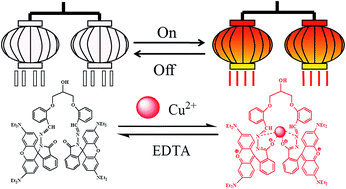A new fluorescent rhodamine B derivative as an “off–on” chemosensor for Cu2+ with high selectivity and sensitivity†
Abstract
A novel fluorescent chemosensor containing two rhodamine B moieties per molecule was synthesized and characterized as an “off–on” fluorescent probe for the detection of copper ions (Cu2+). The crystal structure of the chemosensor was confirmed by X-ray analysis and the recognition mechanism of detecting Cu2+ was proposed with absorption and fluorescence characterization. The chemosensor showed high selectivity and sensitivity and good repetition in sensing Cu2+, and the detection limit is as low as 38.00 nM. In addition, the chemosensor displayed low cytotoxicity as revealed by methyl thiazolyl tetrazolium (MTT) assays and was successfully applied to fluorescence test paper and living cell imaging for detecting Cu2+. Therefore, based on its environmental friendliness and good biocompatibility, the results offered the advantages including the detection of Cu2+ in the environment and bioimaging of intracellular Cu2+.


 Please wait while we load your content...
Please wait while we load your content...